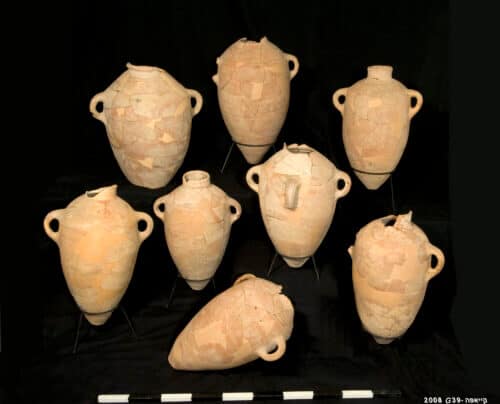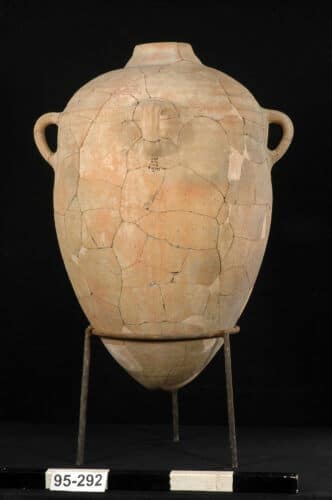Three groups of storage and trading jars that were produced in different places on the island in the 10th to the 7th centuries BC were studied, and it was found that the only parameter common to all three of them with great accuracy is the diameter of the mouths of the jars, and its length is within the range of the various estimates given in the past for the degree of craftsmanship * The test even supports the hypothesis that the production of the vessels in the period in question was entrusted to male potters only

Researchers from the Computational Archeology Laboratory at the Institute of Archaeology at the Hebrew University, from the Weizmann Institute and the Laboratory for Documentation and Digital Research in Archeology at the Antiquities Authority, recently published a study in the archaeological journal BASOR, in which they stated that they Identified the traces of the biblical measure "tap" (the width of four fingers close together) in archaeological findings. The study, which sheds light on a recurring question in archeological research and in halachic literature, examined three groups of storage and trading jars that were produced in different places in the Land of Israel in the tenth to seventh centuries BC, a period identified in the Bible with the period of the kingdoms of Judah and Israel.
The research was conducted in the Laboratory of Computational Archeology at the Institute of Archeology at the Hebrew University of Jerusalem by Dr. Avshalom Karsik, head of the Laboratory for Documentation and Digital Research in Archeology of the Antiquities Authority, Ortal Herosh, a doctoral student in the Laboratory of Computational Archeology, and Prof. Uzi Smilansky from the Laboratory of Computational Archeology and the Weizmann Institute of Science.
The researchers scanned in 300D about 40 jugs that belong to three types of archaeological jugs and have an average volume of about 10 liters - 'Kayafa' jugs dating to the 10th century BC and identified with the Kherbet Kayafa site; 'Hippo' jars dating to the 8th-8th century BC and distributed mainly in the north of Israel; and state trading jugs dating to the end of the 6th-XNUMXth century BC and their main distribution in the Judean and Negev lowlands, and identified, among other things, by the imprints of the "King" seal stamped on their handles. The jugs were mainly used for hoarding, storage and distribution, and it is common to think of them as signs of the presence of a central administration.
In the study, a number of characteristics of the shape and size of the jugs, such as volume, height, maximum diameter, etc., were measured and with them a detailed comparison was made between the groups of jugs. The measurements indicated a lack of uniformity in the sizes measured in each of the groups, and between the average values in the different groups. An exception was one measure that was precisely common to all the jugs: the diameter of the inner opening of the neck of the jug. The measured diameter ranges on average between 88-89 mm which is in the middle of the range of the accepted estimate of the 'tafah' - a measure of the width of four fingers - an ancient measure mentioned in the Bible.
An explanation for the uniformity of the widths of the jugs
The researchers offer an explanation for the uniformity of the jug openings, based on an attempt to analyze the process of making the jug and its use. There is a conflict in the production process of the jar - on the one hand, there is an advantage to a small opening that allows for efficient sealing, which is important for storage and transportation, and on the other hand, a large opening that is more efficient for filling and pouring is preferable. Another constraint is related to the production method of the jugs, which is usually done in parts, and in order to put them together, the potters must insert their hand into the mouth of the jug, so that an airtight and homogeneous connection is possible. In addition, reusing the jars requires a thorough cleaning, especially of the bottom of the jar, which is only possible if the opening is wide enough to insert the whole hand up to the bottom. Another possible consideration that influenced the size of the opening comes from traditions of impurity and purity, so that an opening smaller than a square of tap by tap prevents impurity from entering the contents of the dishes.
According to the researchers, "the width of the season for all these requirements is the size of the tap - which can be easily applied by the various potters, regardless of their time and place. "That was it It is natural for the ancient potters to adopt the size of the pot. This is a unit of length that was widely used in ancient times, and is mentioned both in Assyrian and Egyptian sources and in the Book of the Covenant," the researchers explained in their article.

The connection between the taper and the neck diameters is strengthened by comparing the distribution of the sizes of the jug openings to the measurements of the palm width of men and women from the US Army size databases (The comparison between human palms from such different periods is based on studies cited in the article). "We assume that the physical width of the hand has not changed over the past 3,000 years," the article emphasized. And so, the results of the test showed a surprising match between the distributions of the jug openings and the palm widths of the American men (but not of the American women). These data strengthen the claim that in this case it is clearly possible to identify the use of the ancient culture that was preserved in the process of making the jars and whose average size is 88-89 mm. Also, the test supports the hypothesis that the production of these tools in the period in question was entrusted to male potters and not to women.
More of the topic in Hayadan:
- Remains of a palace were uncovered at the Kyapa site in the Judean Lowlands. Researchers: Palace of King David; Prof. Finkelstein from Tel Aviv University: There is no inscription to prove this, it is likely that it is a building of the Kingdom of Israel
- Researchers from the Hebrew University, the Antiquities Authority and Macquarie University in Sydney: "We have found the biblical Tzkelg"
- The earthquake that destroyed the Canaanite palace in Tel Kaberi from 3700 years ago

One response
In addition to what has been said, it should be noted that "slap" is another word for a hand, for a fist, and is related to a blow.